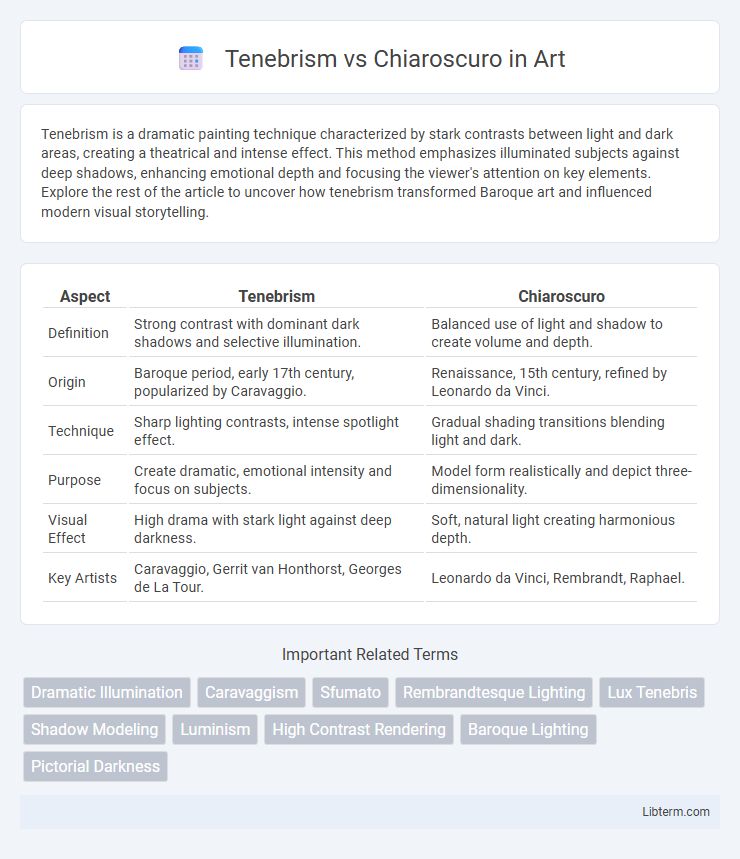Tenebrism is a dramatic painting technique characterized by stark contrasts between light and dark areas, creating a theatrical and intense effect. This method emphasizes illuminated subjects against deep shadows, enhancing emotional depth and focusing the viewer's attention on key elements. Explore the rest of the article to uncover how tenebrism transformed Baroque art and influenced modern visual storytelling.
Table of Comparison
| Aspect | Tenebrism | Chiaroscuro |
|---|---|---|
| Definition | Strong contrast with dominant dark shadows and selective illumination. | Balanced use of light and shadow to create volume and depth. |
| Origin | Baroque period, early 17th century, popularized by Caravaggio. | Renaissance, 15th century, refined by Leonardo da Vinci. |
| Technique | Sharp lighting contrasts, intense spotlight effect. | Gradual shading transitions blending light and dark. |
| Purpose | Create dramatic, emotional intensity and focus on subjects. | Model form realistically and depict three-dimensionality. |
| Visual Effect | High drama with stark light against deep darkness. | Soft, natural light creating harmonious depth. |
| Key Artists | Caravaggio, Gerrit van Honthorst, Georges de La Tour. | Leonardo da Vinci, Rembrandt, Raphael. |
Introduction to Tenebrism and Chiaroscuro
Tenebrism and chiaroscuro are distinct techniques in the use of light and shadow within painting, originating from the Baroque period. Tenebrism is characterized by intense contrasts between dark shadows and brightly illuminated areas, creating dramatic and theatrical effects, often seen in the works of Caravaggio. Chiaroscuro employs more gradual transitions between light and dark, enhancing volume and depth with subtle shading to build three-dimensionality, widely utilized by Renaissance artists like Leonardo da Vinci.
Defining Tenebrism: Origins and Key Features
Tenebrism, originating in the early 17th century Italian Baroque period, is defined by its dramatic use of intense contrasts between light and dark to create a theatrical spotlight effect, emphasizing emotional intensity. This technique features starkly illuminated subjects set against predominantly deep shadows, enhancing a sense of depth and volume far beyond naturalistic chiaroscuro. Key artists like Caravaggio pioneered Tenebrism, using it to evoke heightened realism and psychological tension in religious and narrative scenes.
Chiaroscuro: Historical Context and Techniques
Chiaroscuro, emerging during the Renaissance, revolutionized art by emphasizing the dramatic interplay of light and shadow to create depth and volume. Pioneered by artists like Leonardo da Vinci and Caravaggio, this technique uses gradual shading transitions to enhance three-dimensionality and realism in paintings. Its historical context highlights a shift from flat representations to dynamic compositions that engage viewers through contrast and tonal variation.
Comparative Analysis: Tenebrism vs Chiaroscuro
Tenebrism and chiaroscuro both manipulate light and shadow to create dimensionality, but tenebrism emphasizes stark contrasts with large dark areas dominating the composition, intensifying dramatic effect. Chiaroscuro employs softer gradations of light and shadow, enhancing three-dimensionality and volume without overwhelming darkness. Artists like Caravaggio exemplify tenebrism's bold contrasts, while Leonardo da Vinci demonstrates chiaroscuro's subtle tonal transitions.
Prominent Artists of Tenebrism
Tenebrism, characterized by intense contrasts between light and dark, was prominently advanced by Caravaggio, whose dramatic illumination influenced Baroque painters across Europe. Other key artists of Tenebrism include Artemisia Gentileschi, known for her powerful and emotionally charged compositions, and Georges de La Tour, who employed stark lighting to enhance the spiritual and mysterious quality of his works. These artists distinguished Tenebrism by its heightened realism and theatrical use of shadows, contrasting with the subtler gradations found in Chiaroscuro.
Masterworks of Chiaroscuro
Chiaroscuro masterworks, such as Caravaggio's "The Calling of Saint Matthew," prominently display the technique's nuanced gradation of light and shadow to create depth and volume. Rembrandt's portraits intensify emotional expression through subtle transitions between illumination and darkness, emphasizing texture and form. These seminal works highlight chiaroscuro's capacity to enhance realism and dramatic intensity beyond tenebrism's stark contrasts.
Symbolism and Emotional Impact
Tenebrism emphasizes intense contrasts between dark shadows and illuminated areas, symbolizing dramatic moments of revelation or moral conflict, evoking powerful emotional responses such as fear, tension, or divine intervention. Chiaroscuro employs softer gradations of light and shadow to create a sense of volume and depth, symbolizing the interplay between enlightenment and ignorance, and often evokes nuanced feelings of calm, contemplation, or subtle mystery. Artists like Caravaggio utilized tenebrism to intensify spiritual experiences, while Rembrandt's chiaroscuro highlighted human vulnerability and introspection.
Influence on Art Movements and Styles
Tenebrism, characterized by stark contrasts between deep shadows and intense light, significantly influenced the Baroque period, enhancing dramatic realism and emotional intensity in works by artists such as Caravaggio. Chiaroscuro, emphasizing gradual tonal transitions, played a crucial role in Renaissance and Baroque art by creating volume and three-dimensionality, impacting techniques in portraiture and landscape painting. Both techniques shaped subsequent art movements like Romanticism and Realism by advancing naturalism and expressive depth in visual storytelling.
Modern Interpretations and Applications
Modern interpretations of Tenebrism emphasize dramatic contrasts between intense darkness and illuminated subjects, often used in cinema and digital art to evoke emotional intensity and mystery. Chiaroscuro continues to influence contemporary painting and photography by balancing light and shadow to create depth, volume, and realism, enhancing visual storytelling. Both techniques are adapted in graphic design and virtual environments to manipulate perception and highlight focal points effectively.
Conclusion: The Legacy of Light and Shadow
Tenebrism and chiaroscuro have profoundly influenced the visual language of art, with tenebrism intensifying drama through stark contrasts and chiaroscuro enhancing depth via gradual tonal transitions. Both techniques masterfully manipulate light and shadow to evoke emotional intensity and guide viewer focus. Their legacy endures in contemporary art and cinema, shaping narrative mood and highlighting the interplay between illumination and darkness.
Tenebrism Infographic

 libterm.com
libterm.com